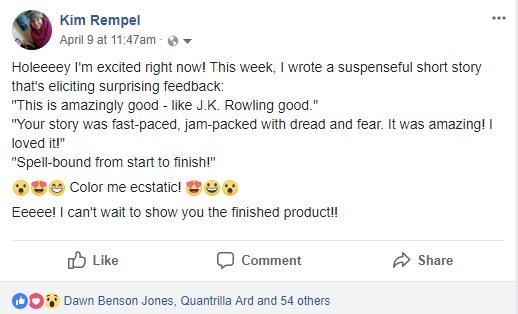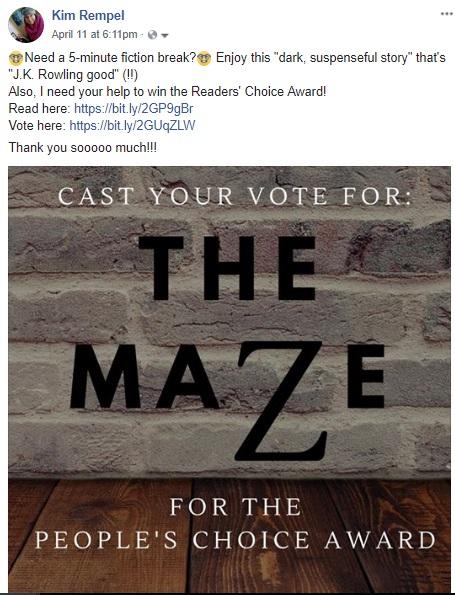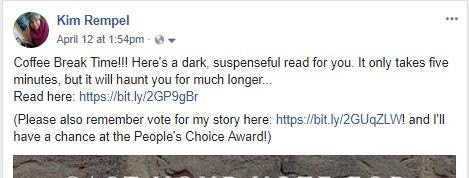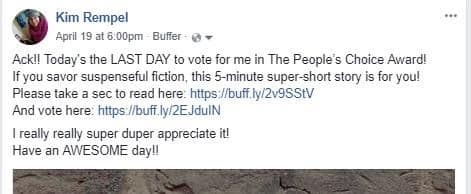“I published a book, didn’t tell a soul about it, and it became a best seller!!”
Said no writer ever.
But we wish it were true, don’t we?

We want to hole up and write epic tales and thought-provoking prose, not hock books door to door and shout from the rooftops about how awesome we are. Can’t we just write? Well … write, but also be discovered and then catapulted to great heights by someone else.
We’d like readers to find us that way, please. We don't want to navigate those scary waters of how to market a book.
How I Used to Market My Writing (Or Not)
Ten years ago, an author friend of mine had published her first novel and was so proud of it. She seemed to be able to weave it into every conversation she had — with family, friends, even the Walmart cashier she didn’t know from Adam. She would talk excitedly about it, and people would buy her books. It was incredible to watch.
Meanwhile, I had published a book at the same time. I was also proud of it, but incredibly uncomfortable talking about it. So, unless someone asked, I didn’t mention my book. And I certainly didn’t offer it for sale. It felt too pushy.
So I literally put it in a box in my closet and secretly wondered why my friends didn’t love me enough to ask about and buy my new book. (Pro tip: That's not how to market a book.)
My friend, on the other hand, instinctively knew that to sell books one has to (are you ready for this?) … sell books. And she’s been steadily making people very happy with her stories ever since.
Fast forward a decade and I’ve learned a lot. Now, as a published nonfiction writer for over twelve years, an editor, and an online marketer, I’ve learned some stuff that has helped me and others sell books.
This understanding of how to market a book even helped me win the Readers' Choice Award in the Spring Writing Contest for my story The Maze!
5 Winning Strategies for How to Market Your Writing
Here’s the thing: I may be an experienced writer, but I’m a new fiction writer. My story that won the Reader’s Choice Award was only my second-ever short fiction story. But it didn’t win just because it was a good story. There were lots of good stories, any of which could have won.
I also didn’t win by accident.
Winning the Readers’ Choice Award isn’t about writing something epic and then hoping to be discovered.
There were five strategic things I did to improve my chances, and I want to give you a backstage pass to them.
You might wonder why I wouldn’t just keep the secret to myself. I’ll tell you. It’s because I’m passionate about helping authors with marketing online. It’s what I do!
My hope is that these tips will do much more than help you win the award for yourself — these tips will help expand your reach online, help you impact readers with your writing, and boost your bottom line, too.
Here are the five things I did — and that you can do — to improve the chance of winning:
1. Write Something Excellent
Job number one in this or any writing endeavor is writing a top notch story. If your story isn’t a serious contender for the win, park on this step until it is. Otherwise your story isn’t ready for the steps that follow.
The first time I entered the contest, I thought my story was mediocre but had potential. Not bad for a newbie, I thought.
Then I read some of the other entrants’ drafts, and knew I didn’t stand a chance. Mine pretty much sucked.
And that was okay. I was totally new to fiction and had come to practice and learn anyway. (I wrote a piece here about why writers should embrace the process of writing crap.)
Knowing it wasn’t a contender, I sure didn’t ask a single person to vote for my story. I don’t even think I mentioned I was participating. I just quietly practiced, hoping one day I would be better at writing fiction.
For this year’s contest, I had the makings of a great story that fit squarely in the guidelines. I’d grown in skill. I’d grown in the ability to ask for input and then change my story accordingly. And, this time, I was determined to make even better use of the workshopping process to make the story better.
Three or four drafts later, and after reading many of the other stories, I felt like mine could compete with the very best. Not win the grand prize, maybe, but then again, it had a chance.
I was proud of what I had created and was certain others would enjoy it too.
I was ready to tell people about it.
2. Create a Cover Image for Your Story
It’s tempting to just copy and paste the link to your story and start sharing to social media. But there are two problems with that.
First, the contest has a single image that’s used for the overall contest. That means it won’t have any correlation to your story at all. A picture of a spring landscape won’t tell your readers a thing about your character’s attempt to hide a body before dinner guests arrive.
So people won’t click. Which means they won’t read.
Secondly, the contest has a single image that’s used for the overall contest, which also means that every writer who copies and pastes the link is going to have the same exact photo showing up.
You worked so hard on your story, now it’s time to put effort into getting people to read it.
They’ll click if the image (and accompanying text) is compelling. We’ll get to the text part in a minute.
Here is the image I used for my story:

How to Create Your Cover Image (It’s easy and FREE!)
I use a free online software called Canva.com to create many things, including the cover image for my short story. They have a selection of free public domain photos to use, or you can use images from Pexels.com or Unsplash.com. (Just remember, when using images, to use ones with the proper permissions.)
3. Share Strategically on Social Media
An awesome image isn’t enough. People need a reason to go to the work of clicking and reading and voting. It’s got to be more than just, “Here’s my story! Please read it!” Instead, ask yourself, “What’s in it for them?” and, “Would I click on this if someone else posted it?”
Here are some examples of the image (and accompanying text) I created to garner those desirable clicks:
The first time I ever spoke about it publicly my story was still being workshopped. Already it was getting killer reviews. So I used them to announce what I was doing and create anticipation.

Days later I added a cover image and did a few strategic things in the text.
- First, I enticed them with a clear, concise promise — a short thrilling break from reality.
- Also, as a marketer, I know that, while emojis may seem silly, they get increased attention, so I included two.
- Then I leveraged the social proof (existing awesome feedback) to draw them in even more. Because we all want to do things other people say are awesome, right?
- Then I included links. Don’t forget the links! Make it as easy as possible for them to do what you’re asking.
- Then I showed my deep gratitude, demonstrating how meaningful it was to me that they would do such a thing.
Your post doesn’t need to include all these elements, but it should include at least some.

I posted daily, varying the time of day and even the text occasionally. Here’s one variation, for example, which includes most of the elements listed above.

I can hear your objections. “Kim! You posted daily? Didn’t that come across as pushy?? I don’t want to be like that.” I hear you. I don’t want that either.
Here’s the thing you might not know about Facebook. Only three percent of your audience is likely to see your posts anyway. That’s it. And then, time of day plays a huge factor too — a different three percent might see your posts in the morning than in the evening.
To make it worse, the average life span of a FB post is ninety minutes. After that, it disappears in the abyss of the newsfeed, falling deeper and deeper into obscurity.
People want to see your post, but you have to help them see it. That happens with daily posting and at different times.
If you’re still feeling wary about oversharing, there’s one more thing to remember — it’s for five days. If one percent of people are mildly annoyed by seeing a duplicate post of yours (and you can easily tweak them so they’re not identical), they’ll overlook it if it’s just for five days.
4. Private Message People
Facebook posting isn’t enough. Even with varied content and times, and amazing images, I knew my friends — even my closest, most supportive friends — wouldn’t necessarily see it. They might have no clue I was doing this or needing their vote.
I decided to do the brave thing and just ask them. One on one. Like a human.
I’d read about such advice, heard about it, seen people do it even (reaching out to me to add their music to my playlist for example), but had never been brave enough to try it. What if they’d be annoyed by my asking? What if it would ruin our relationship, and they’d pretend not to see me at church the next week?
Screw it. I’ve got to try.
So I went through my contacts and, one by one, messaged those with whom I had a rapport of some kind. If we’d spoken in the last year, they were on my radar.
I crafted three template messages for three different kinds of relationships, so I wasn’t having to write the whole thing from scratch every time. I pasted a template into a message, then tweaked it to be more personal — included their name, perhaps a reference to a recent conversation, just to make it real.
Then, with trembling finger and bated breath, I clicked send.
(A note as you’re doing this — do not spam people. These messages were sent to people I had already had a connection with.)
Here’s what surprised me. People were excited for me. They thanked me for telling them about it. Even self-labeled “non-readers” or people who “don’t read fiction” made the effort to click, to read, and to vote.
It was incredible! I was blown away by the support, and so thankful I didn’t back down in fear.
5. Send Reminders
On the last day voting was open, I posted a reminder to social media, using the same elements of an effective post as I’d used before. I also sent private message reminders to those I’d messaged earlier and who had either not read it, had not responded, or had said they’d “read it later.” Because you and I both know later is a time that never comes.
I was still nervous about coming across as a giant pain in the neck, but I remembered something: there have been many times I intended to do something — even attend a friend’s event — and forgot. Those times I got a reminder, I was grateful, not annoyed. I trusted that’s how this would be received, and kept plodding forward.

The result of all this effort (and it WAS effort) was my first-time win of the Readers’ Choice Award. I was pumped — not just because of the award. I was pleased because my experiment had worked and I knew it would work for others too; for you.
What I Learned From the Readers' Choice Award
Now at the end of the Readers' Choice Award, I've drawn two major takeaways:
1. Workshopping is critical
Excellent writing doesn’t happen in a vacuum. It happens when we get excellent feedback on how we can improve our writing.
The fact that this contest offers a workshopping element blows me away. That alone is worth every shiny nickel.
For me, this process has been about learning more than anything — it’s why I entered at all. I may have experimented with the marketing bit and learned from that, but it’s the workshopping where the learning about writing happens. I highly recommend taking full advantage of it!
2. People are more willing to help than you think
Speaking of workshopping, I was blown away with the generosity of my fellow writers. They gave so much of themselves — their time and input — it moved me. I’m serious. There are a whole lot of selfish groups a person can be a part of, and I’ve seen a bunch. This was certainly not one of them.
To the writers of Spring 2018 contest — thank you! You seriously rock.
As a member of several private Facebook groups, I was also blown away by the massive support from my friends there. Others were even initiating promoting my story to the group! It was incredible.
As you reach out to people, develop relationships, and make those connections, I think you’ll discover as I have — people are more willing to help than you think.
The Secret to Marketing Your Writing
The thing we writers need to remember is readers. Writing is only half the job. The other half is getting those hard-won words into the hands of readers.
Here’s what I know about readers: they don’t know about your awesome writing or why on earth they should read it if you never tell them. Like it or not, it’s our job as writers to tell them.
Which of these elements of how to market a book do you feel you most need to work on? Share in the comments!
PRACTICE
Talking to others about your work is scary. It’s also necessary. (You didn’t work this hard just to hide it in a drawer, did you?) Reaching out to others also takes practice. All of this does!
Your homework today is to grow in courage and practice sharing your work on social media in a creative and intriguing way.
First, select an excellent published piece of your work that you’re proud of. (Perhaps your contest entry or a blog post.)
Then, take fifteen minutes to prepare it to share:
1. Create your own cover image for that piece at Canva.com.
2. Then, craft a compelling social media post to go with your image.
3. Share it with your audience. You can do it!
When you're done, come back and tell us in the comments how it went and what surprised you about it. And be sure to comment on your fellow writers' experiences and encourage them, as well!
This article is by a guest blogger. Would you like to write for The Write Practice? Check out our guest post guidelines.



0 Comments